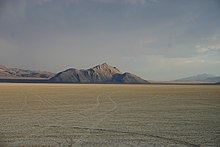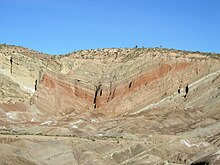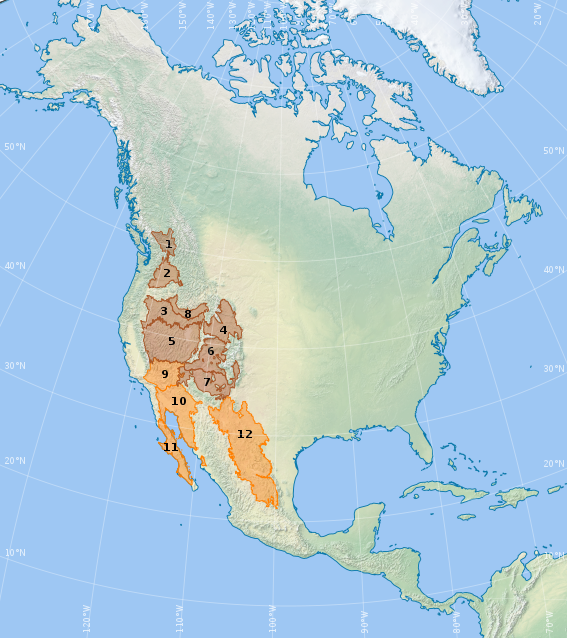List of North American deserts: Difference between revisions
No edit summary Tags: Reverted Mobile edit Mobile web edit |
m fix broken link |
||
| Line 4: | Line 4: | ||
[[File:PtdDesert.jpg|thumb|Aerial photo of the [[Painted Desert (Arizona)|Painted Desert]] in [[Petrified Forest National Park]], Arizona]] |
[[File:PtdDesert.jpg|thumb|Aerial photo of the [[Painted Desert (Arizona)|Painted Desert]] in [[Petrified Forest National Park]], Arizona]] |
||
[[File:Rainbow Basin.JPG|thumb|A geological [[syncline]] in the [[Mojave Desert]] near [[Barstow, California|Barstow]], [[California]]]] |
[[File:Rainbow Basin.JPG|thumb|A geological [[syncline]] in the [[Mojave Desert]] near [[Barstow, California|Barstow]], [[California]]]] |
||
[[File:White sands national monument dune.jpg|thumb|Unusual [[gypsum]] dunes at [[White Sands National Park]] in the [[ |
[[File:White sands national monument dune.jpg|thumb|Unusual [[gypsum]] dunes at [[White Sands National Park]] in the [[Chihuahuan Desert]]]] |
||
Desert]]]] |
|||
[[File:Saguaro cactus Aan04.jpg|thumb|right|[[Saguaro]] (detail), icon of the [[Sonoran Desert]]. Photo by [[Ansel Adams]], c.1941]] |
[[File:Saguaro cactus Aan04.jpg|thumb|right|[[Saguaro]] (detail), icon of the [[Sonoran Desert]]. Photo by [[Ansel Adams]], c.1941]] |
||
[[File:TuleHorses.JPG|thumb|[[Mustang]]s run across a Sagebrush steppe, [[Tule Valley]], [[Utah]]]] |
[[File:TuleHorses.JPG|thumb|[[Mustang]]s run across a Sagebrush steppe, [[Tule Valley]], [[Utah]]]] |
||
Revision as of 15:35, 2 February 2023








This list of North American deserts identifies areas of the continent that receive less than 10 in (250 mm) annual precipitation. The "North American Desert" is also the term for a large U.S. Level 1 ecoregion (EPA)[1] of the North American Cordillera, in the Deserts and xeric shrublands biome (WWF). The continent's deserts are largely between the Rocky Mountains and Sierra Madre Oriental on the east, and the rain shadow–creating Cascades, Sierra Nevada, Transverse, and Peninsular Ranges on the west. The North American xeric region of over 95,751 sq mi (247,990 km2) includes three major deserts, numerous smaller deserts, and large non-desert arid regions in the Western United States and in northeastern, central, and northwestern Mexico.
Overview
The following are three major hot and dry deserts in North America, all located in the Southwestern United States and Northern Mexico.[2]
- The Chihuahuan Desert is the largest hot desert in North America, located in the Southwestern United States and Northern Mexico. Its total area is 140,000 sq mi (360,000 km2).
- The Sonoran Desert is a desert located in the Southwestern United States and northwest Mexico. It is the second largest hot desert in North America. Its total area is 120,000 sq mi (310,000 km2).
- The Mojave Desert is the hottest desert in North America, located primarily in southeastern California and Southern Nevada. Its total area is 22,000 sq mi (57,000 km2).
The largest cold desert is the Great Basin Desert, which encompasses much of the northern Basin and Range Province, north of the Mojave Desert.
Other cold deserts lie within the Columbia Plateau/Columbia Basin, the Snake River Plain, and the Colorado Plateau regions.
Full listing

(listed from north to south)
- Great Kobuk Sand Dunes three small deserts in northwestern Alaska, part of the Kobuk Valley National Park
- Yukon - Carcross Desert, smallest desert in the world
- Washington – British Columbia – Idaho – Wyoming – Oregon – Nevada
- Much of the Columbia Basin is desert, such as the
- Channeled Scablands, a desert in the Columbia Basin of eastern Washington
- Most of the Snake River Plain (ecoregion) is sagebrush steppe, but barren lava fields form small deserts, such as
- The Wyoming Basin (ecoregion) is dominated by arid grasslands and shrub steppe, but also contains the
- Owyhee Desert, in southwestern Idaho, northern Nevada, and southeastern Oregon.
- Y P Desert, a portion of the Owyhee Desert in Idaho
- Oregon High Desert, aka "Great Sandy Desert", eastern Oregon
- Alvord Desert, a dry lake bed.
- Northwest Lahontan subregion in Nevada-part of the Northern Basin and Range (ecoregion)
- Black Rock Desert, a dry lake bed.
- Much of the Columbia Basin is desert, such as the
- Great Basin Desert
- Nevada, dominated by sagebrush steppe
- Forty Mile Desert, in northwest Nevada
- Smoke Creek Desert, Nevada (980 sq mi)
- Carson Desert
- Utah
- Great Salt Lake Desert, Utah
- Sevier Desert surrounds the intermittent, salty Sevier Lake
- Escalante Desert (3,270 sq mi)
- Nevada, dominated by sagebrush steppe
- Colorado Plateau
- Utah
- San Rafael Desert, the drier portions of the San Rafael Swell
- Colorado, dominated by pinyon–juniper woodlands, but contains desert areas where unfavorable soil conditions exist:
- Utah
- Mojave Desert
- California (the High Desert); and parts of western Arizona, southern Nevada, and a small portion of Utah.
- Death Valley, California
- Amargosa Desert, Nevada
- California (the High Desert); and parts of western Arizona, southern Nevada, and a small portion of Utah.
- Sonoran Desert
- Colorado Desert, Southern California (the Low Desert)
- Yuha Desert, Imperial Valley, California
- Yuma Desert, southwest Arizona
- Lechuguilla Desert, southwest Arizona
- Tule Desert (Arizona) and Sonora, Mexico
- Gran Desierto de Altar, Sonora, Mexico
- Baja California Desert, State of Baja California, Mexico
- Vizcaíno Desert, central State of Baja California, Mexico
- Colorado Desert, Southern California (the Low Desert)
- Chihuahuan Desert
- Trans-Pecos Desert, west Texas
- White Sands, unusual gypsum dune field in New Mexico
Western arid regions of North America
The separately defined western arid regions of North America are continental regions of aridity based on available water in addition to rain shadow-diminished rainfall[3] and which have many non-desert shrub-steppe (EPA) and xeric shrublands (WWF) in addition to desert ecosystems and ecoregions. This large arid region of 190,000 sq mi (490,000 km2) includes: deserts, such as the Great Basin Desert and Sonoran Desert; and the non-desert arid region areas (with greater than 10 inches (250 mm) annual precipitation) in the Great Basin arid region, Colorado Plateau, Mexican Plateau, and others. This arid region extends from the top of the North American Desert in Washington and Idaho southward into Mexico in the Trans-Mexican Volcanic Belt. The 'western arid region' is east of and (except for Mojave sky islands) discontiguous from the Mojave Desert,[4] unlike the southwestern Great Basin deserts adjacent with ecotones to the northern Mojave Desert.
See also
- Desert ecology
- Desert of Maine
- Deserts and xeric shrublands – biome and ecoregions
- Deserts of California
- Great American Desert
- List of deserts
- List of deserts by area
- North American Deserts in List of ecoregions in North America (CEC)
- North American Deserts in List of ecoregions in the United States (EPA)
- Semi-arid climate
References
- ^ EPA, OA, OEAEE, OWC, US. "About the National Health and Environmental Effects Research Laboratory (NHEERL) – US EPA". US EPA. Retrieved 11 April 2018.
{{cite web}}: CS1 maint: multiple names: authors list (link) - ^ "Desert Biome". University of California Museum of Paleontology.
- ^ (1953 Meigs criteria)
- ^ "The World's Largest Desert". Geology and Earth Science. geology.com. Retrieved 2010-04-25.
- Deserts of the United States
- North America-related lists
- Lists of deserts
- United States geography-related lists
- United States science-related lists
- Deserts of Mexico
- Deserts and xeric shrublands
- Geography of North America
- Geography of Canada
- Geography of the United States
- Geography of Mexico
- Regions of Canada
- Regions of the United States
- Regions of Mexico
